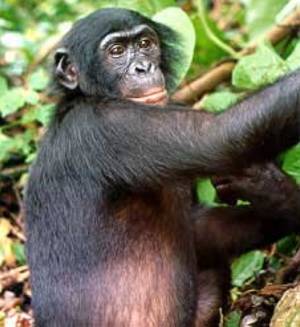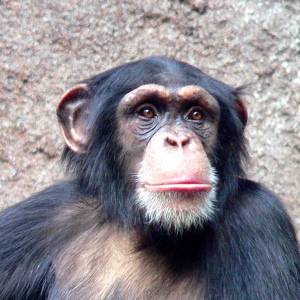Bonobo-chimpanzee Hybrids
Pan paniscus × Pan troglodytes
Mammalian Hybrids
|
For he who is acquainted with the paths of nature, will more readily observe her deviations; and vice versa, he who has learnt her deviations, will be able more accurately to describe her paths.
—Francis Bacon, Novum Organum
|
Hybridization between chimpanzees (Pan troglodytes) and bonobos, also known as pygmy chimpanzees, (Pan paniscus) has occurred in captivity (Vervaecke and van Elsacker 1992, Vervaecke 2002; Vervaecke et al. 2004).
In 1979, a circus director in France bought what he believed to be a male chimpanzee. It performed in acts and regularly mated with two female chimpanzees. This male ape, however, turned out to be a bonobo. Between 1991 and 2000, seven bonobo-chimpanzee hybrids were produced from these matings, most or all of which survived. By 2000, the oldest was working in the circus act in place of his retired father.
Apparently, natural bonobo-chimpanzee hybrids have not as yet been reported. The ranges of these two apes are separated by the Congo and the Lualaba rivers. Untrained apes cannot swim and are afraid of water. Moreover, the two rivers in question are crocodile infested. So relatively little opportunity for contact and hybridization exists.
But bonobos and chimpanzees may, at least on rare occasion, meet upstream of Boyoma Falls (formerly known as Stanley Falls) where the river can easily be crossed, even by humans, during times of low water. Fenart and Deblock (1973, p. 11) note that there is one point there where it is possible to cross by jumping from rock to rock at low water, but that a search of that area revealed no evidence of naturally occurring bonobo-chimpanzee hybrids. Obviously, however, a more thorough survey of the forests adjacent to this contact point might turn up something that Fenart and Deblock missed.
The most reliable report of bonobo-chimpanzee hybrids appears in a brief abstract of a presentation given at the Spring 2003 meeting of the Primate Society of Great Britain. There, Vervaecke et al. (2004) state the following: “From historical accounts it appears that natural populations of bonobos and chimpanzees have been allopatric [that is, separate] since their
Actually, despite Vervaecke's denial of any evidence for natural hybridization, more recent research suggests that such hybridization has occurred at some indefinite time in the past (see below).
Other crosses involving great apes >>
Pearson (2012, p. 280) says that the primary karyologic difference between the common chimpanzee and the pygmy chimpanzee, which consists “of a pair of small acrocentrics in the former being replaced by a metacentric chromosome in the latter (Hamerton et al., 1963), has been ascribed to the presence of extremely large fluorescent short arms and satellites on the P. paniscus chromosome 23 (HSA 22).” He then states that his laboratory had recently examined an individual that was supposedly a pygmy chimpanzee (P. paniscus) “and found that only one P. paniscus chromosome 23 had fluorescent satellites (Fig. 8), indicating that this was either a polymorphic difference within the species [i.e., that some P. paniscus individuals have this fluorescent version of chromosome 23 and that others don't] or that the animal examined was a hybrid between P. troglodytes and P. paniscus.” He then goes on to say that “There is no evidence to suggest the latter.” But it is not easy to see why, given his finding, that he would think there is no such evidence. The very fact that the individual in question possessed two types of chromosome 23 (one characteristic of common chimpanzees, the other characteristic of pygmy chimpanzees) is very strong evidence indeed. In fact, in many studies involving other pairs of organisms less closely related to humans (and where there is therefore less bias) such evidence is taken as sufficient in itself to establish that the specimen in question is a hybrid.
In addition, de Manuel et al. (2016) argue that genetic evidence indicates that extensive ancient hybridization has occurred between bonobos and chimpanzees .

